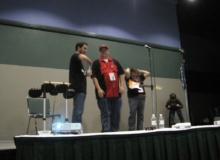Anyone who has been reading this blog for awhile knows that I am pretty liberal about what I let my kids play, watch and read. That being said we are fairly discriminating about things that are rated for an age group older than our kids. Video games that glorify violence for violence’s sake (like GTA and Saint’s Row) are big no-nos in our house. Once in awhile, though, a rated M game comes out that we feel is okay for Nate to play as long as we talk about it and supervise his playing.
 |
| Being an Assassin isn’t all rainbows and ponies. |
One such example is the Assassin’s Creed franchise from Ubisoft. Yes, you are an assassin. There is a certain amount of implied violence that comes along with that. You spend a lot of time in the game skulking around in the shadows and attacking people, and there is pleny of blood. As a redeeming point, you are an assassin to fight the bad guys. Your motto being “we work in the dark to serve the light”.
The premise is that you are Desmond Miles, a barteneder in the year 2012. (Okay it gets a little ridiculous here, bear with me). You are a descedant of Altaïr ibn La-Ahad, a medieval assassin during the Third Crusade and Ezio Auditore da Firenze, a young nobleman from 1476 in Florence. Using technology that involves DNA sequencing Desmond is able to relive his descendants’ lives. The whole point of this ridiculousness is to get information that will lead you to an artifact that is lost in the game’s present and to find it before the bad guys- Templars, of course – do.
There are a couple of things that make this game appealing to me as a parent. For one, you have to make good desicions. Killing innocents will cost you life and make you restart the mission. Yes, you’re killing people, but you’re killing only the bad guys and learning consequences.
Second, the developers at Ubisoft have gone above and beyond when it came to researching the game for historical accuracy. (There is a really long blog article here from Penn State that goes talks about some of the minute details in the first installment of the game that show just how much thought was put into it). At every point of historical significance in the game you are presented with an opportunity to read your “database”. The database is essentially an accurate history article about whatever your looking at, providing hundreds of teachable moments during game play. At one point, after finishing the mission part of Assassin’s Creed II Super-Dad decided to become an in-game art collector. He would send Ezio on missions to make money and then buy art so that he could read the descriptions. It was pretty cool to learn about famous renaissance paintings while playing a video game.
In Assasssin’s Creed II and in Assassin’s Creed: Brotherhood Leonardo DiVinci is featured heavily playing Q to Desmod/Ezio’s James Bond. Intrigued by all of the contraptions that DiVinci provides Ezio, Nate checked out a DiVinci bigoraphy from the library. He’s spent the past three days telling me about DiVinci’s crazy inventions. You may disagree with me about the appropriateness of these games, but MarioKart has never inspired my son to do further investigating at the library.







